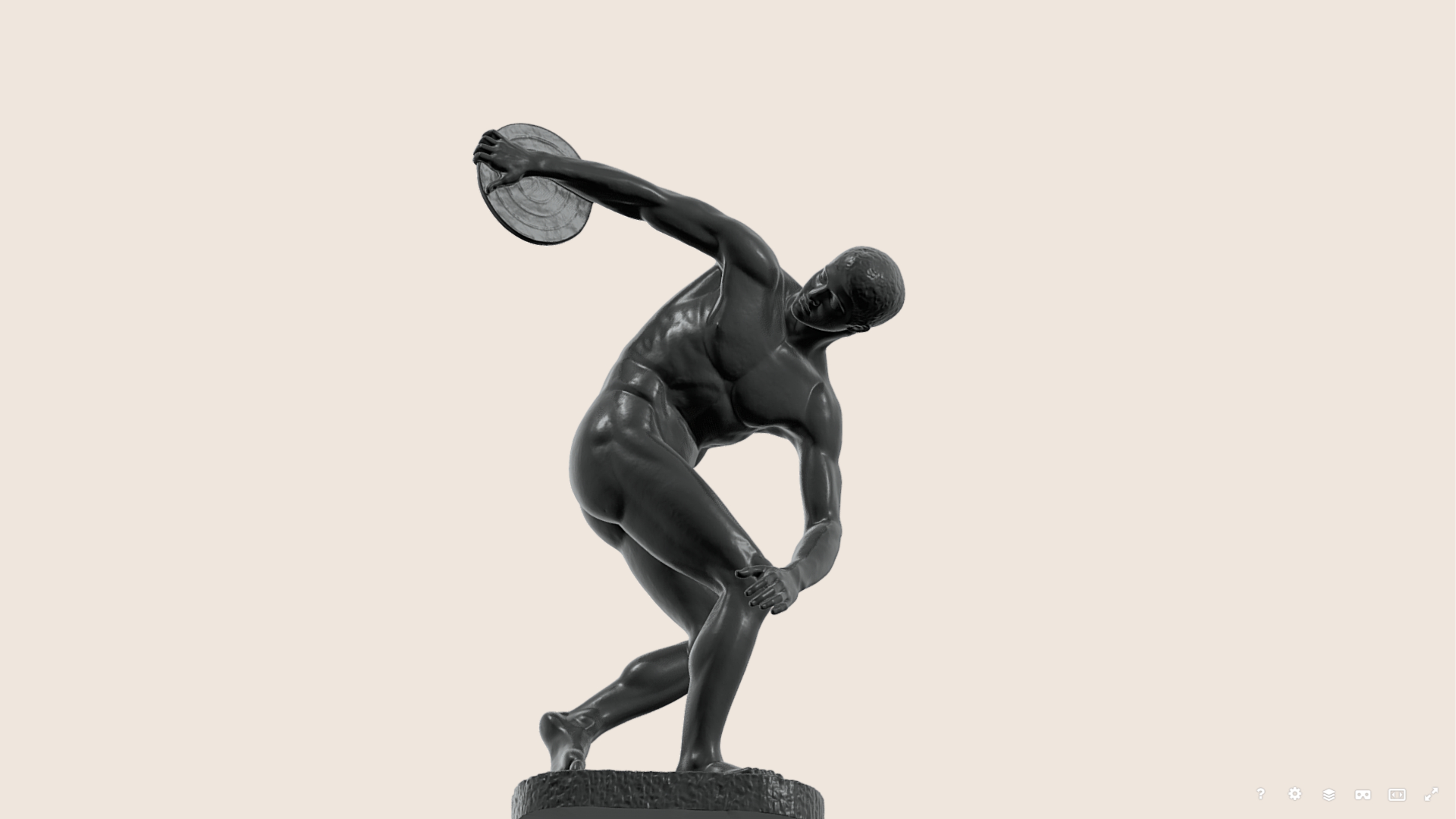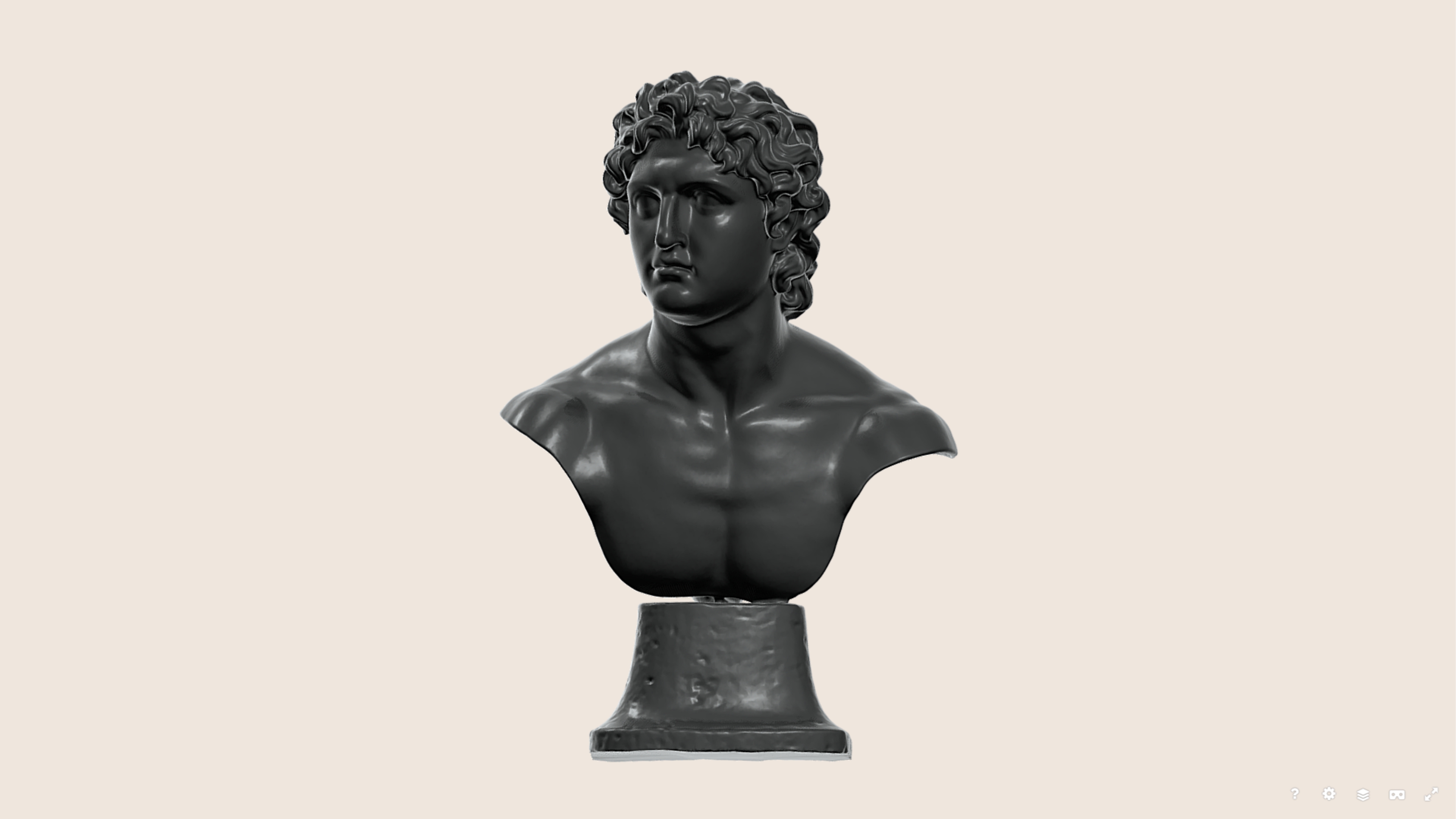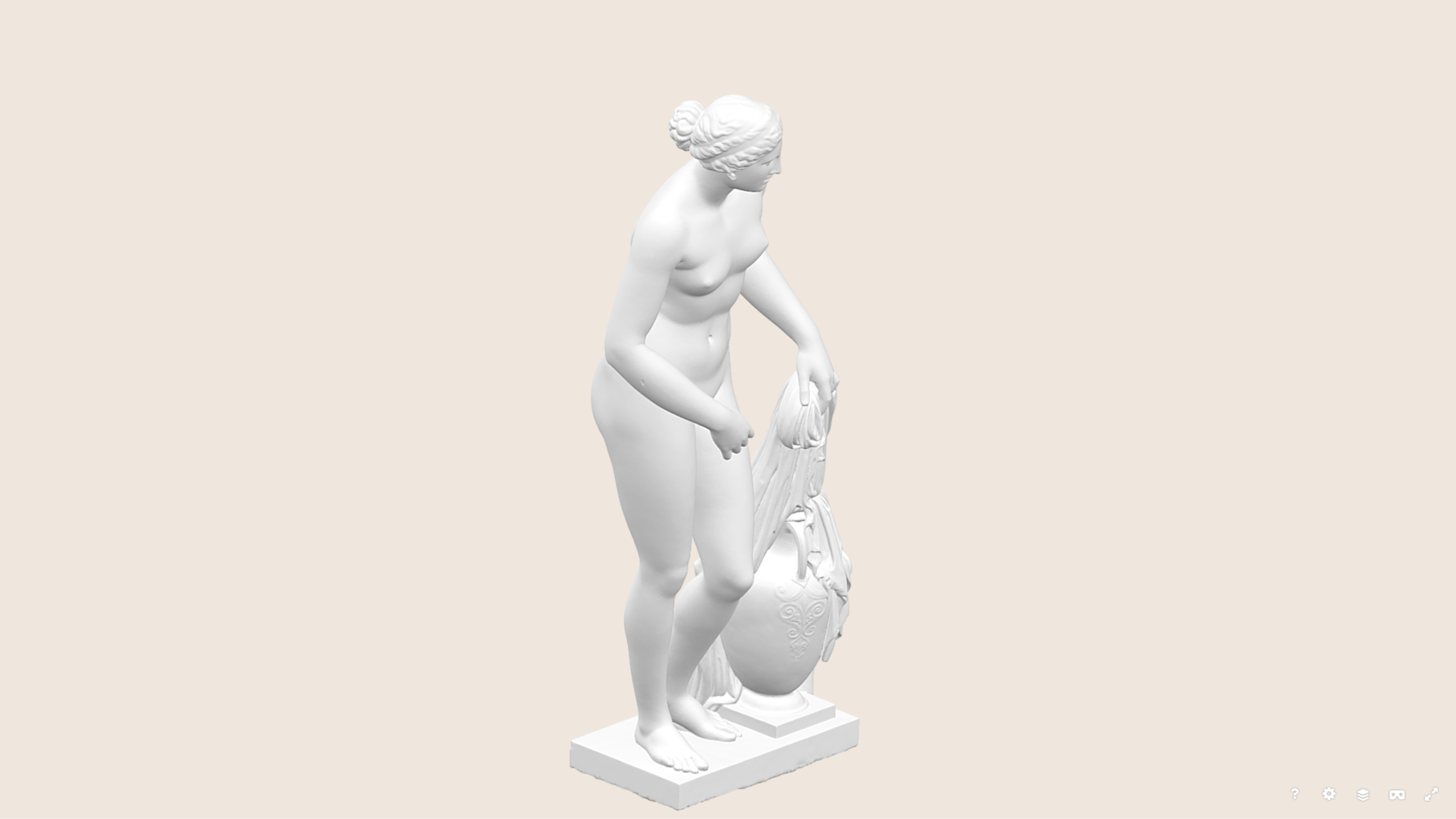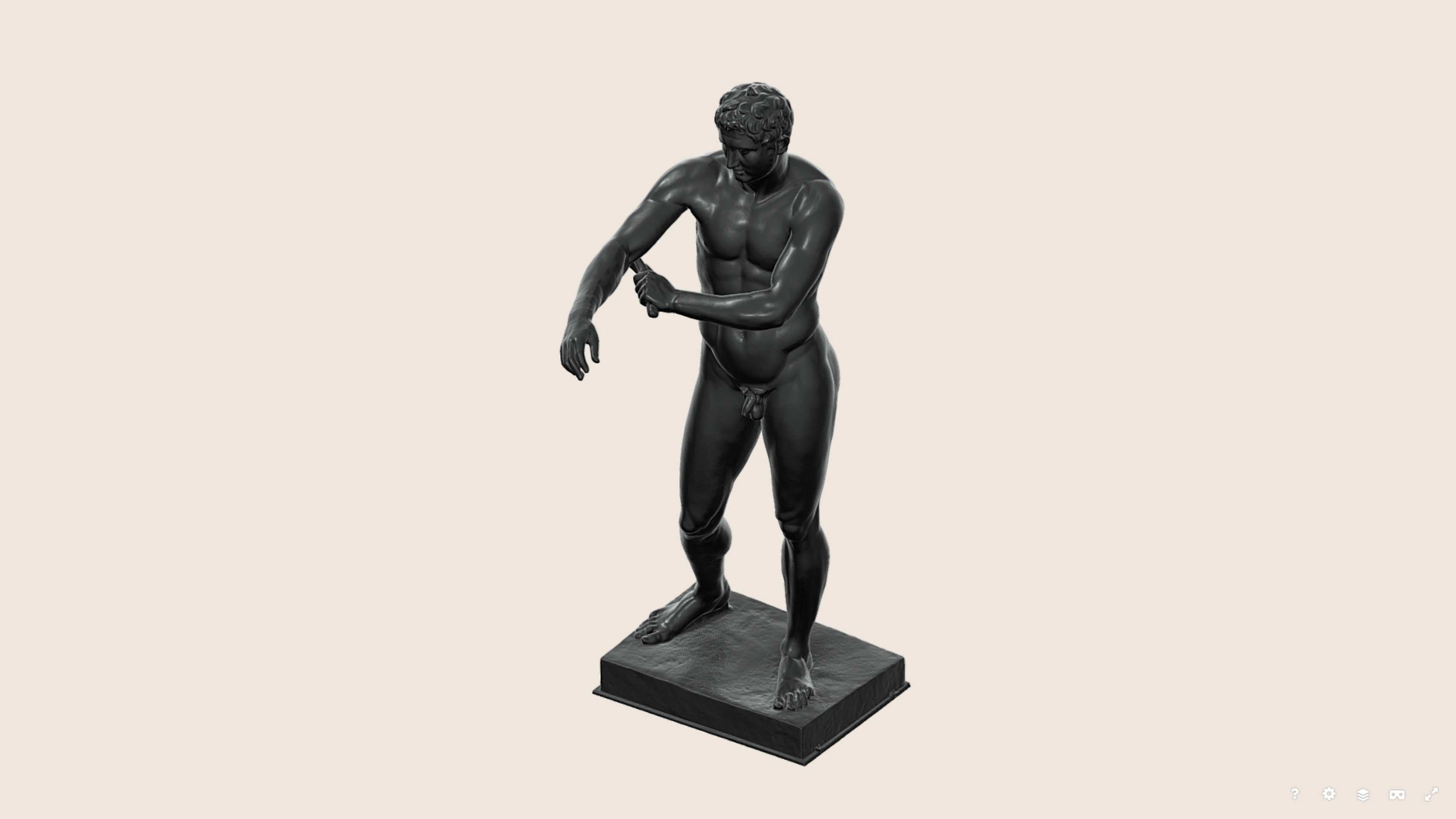On account of the cooperation with Fundacja Wirtualizacji Narodowego Dziedzictwa Kulturowego (Foundation for Virtualisation of the National Cultural Heritage) we are happy to present another – after Duke Philip I by Lucas Cranach the Younger at 17,000,000,000 Pixels – etraordinary virtual project.
This time we would like to invite you to detailed exploration of 3D scans of objects selected among the largest European collection of bronze reconstructions of famous ancient sculptures. The exhibits are presented at the permanent exposition entitled "Ancient Roots of Europe. Dohrns' Szczecin Collection” in the National Museum in Szczecin at Wały Chrobrego.

Dohrn's Antiquarium (all objects): CLICK
3D model links may also be found in the titles of particular sculptures.
The Discobolus
Myron of Eleutherae, ca. 460–450 B.C.
copy made of bronze in years 1905–1909 at WMF Geislingen (Germany)
Myron, one of the most famous sculptors of the classical period, worked around 480–445 B.C., mainly in Athens. He was famous for the sculptures set on the Acropolis of Athens, including the depiction of a cow being led to be sacrificed, reportedly so realistic that some lions attacked it.
"The Discobolus" was valued for its author's effective approach to the subject. The discus thrower was captured in a brief moment of rest, concentrating forces before making a sudden movement. Despite its innovative character, Myron's sculpture has retained many features of the art of the archaic period. It is a "relief detached from the background", intended to be viewed only from one frontal perspective.
The original sculpture has not survived and it is known on account of several damaged copies and descriptions. Szczecin's "Discobolus" is a reconstruction of the alleged original appearance of Myron's work, made according to the concept of A. Furtwängler (some parts, including the head and the hand with a disc, were reconstructed).

Apoxyomenos
Lysippos of Sicyon, ca. 330–320 B.C.
bronze copy made in years 1905–1909 at WMF Geislingen (Germany)
Lysippos, who worked in the years 350–330 B.C., was the last of the great Greek artists of the classical period. Close to Alexander of Macedon, he accompanied him on his expeditions. Contrary to the classics (Phidias, Polykleitos, Myron), his assumption was not to reach the abstract ideal of beauty by perfecting the form (e.g. by mathematical calculations), but to observe and imitate nature. He created his own canon of depicting the figure, more heavy-set and muscular in relation to the canon of Polykleitos, which was initially a model for him.
Apoxyomenos is a depiction of an athlete during his toilet after a competition – a topic often taken up by artists of that time. After the bath, one rubbed themselves with oil, and its excess was removed from the skin with a bronze scraper (strigillum). A casual pose and stretched out arm break with the traditional pursuit of maximum harmony and peace. Lysippos introduces movement into his work, which adds some boldness to the composition and enriches the image of the musculature.
Apoxyomenos was famous in the ancient times. The Roman emperor Augustus moved the statue to public baths in Rome. His successor Tiberius, delighted with the beauty of the sculpture, wanted to move it to his private apartments, but had to give up this intention due to the outrage of the people.
The original sculpture was lost during the fall of Rome, but numerous quality copies have survived. The most faithful is the statue found in 1849 in the Vatican collection, which served as the model for the sculpture of Szczecin.
Alexander the Great (?) so-called Alexander Rondanini
Leochares (?), ca. 330–320 B.C.
bronze copy, made in years 1905–1909 at WMF Geislingen (Germany)
The portrait is a fragment of a statue depicting Helios, the god of the Sun, located in Olympia. The sculpture has been traditionally considered to be the image of Alexander the Great (356–323 B.C.), the king of Macedonia, one of the most famous leaders of antiquity, who extended Greek rule and culture to the Middle East and Egypt. Alexander was sometimes compared to Helios which may have brought the supposition that he was portrayed as the Sun deity. The traditional name of the sculpture comes from the Italian family to which it belonged for a long time.

Boy with Thorn (called Spinario)
Pasiteles, 80–50 B.C.
bronze copy made in years 1905–1909 at WMF Geislingen (Germany)
The statue was sculpted three centuries after the times of Polykleitos; it was, however, created in the spirit of his sculptures, so at the beginning of the existence of the Szczecin collection it was commonly attributed to this master. The creator of the work was probably Pasiteles, a Greek who settled in Rome, one of the most famous sculptors of the first century B.C., valued by, among others, Cicero. The bronze sculpture was found in Rome at the beginning of the Renaissance and was greatly popular as a rare example of a Greek bronze original.

The Aphrodite of Knidos
Praxiteles of Athens, 364–361 B.C.
marble copy made in years 1905–1909 in Rome by sculptor Hans Everding
Praxiteles (working ca. 370–340 B.C.) is considered one of the two greatest Greek sculptors of the 4th century B.C. Initially, he followed the example of Phidias, but with time he developed his own style and canon. Compared to the sculptures of the 5th-century masters, his works are lighter and more slender, and their silhouettes are more dynamic. In ancient times, he was considered a master of charm, showing the gods as beautiful, youthful, careless beings.
The statue of Aphrodite made of marble for the temple of this goddess located on the island of Knidos was one of his most famous sculptures. Contrary to traditional figures, Praxiteles showed the deity naked, while entering a bath. The contrast between the smooth body and the pleated fabric emphasizes the perfect beauty of the figure. The statue of Aphrodite was considered a work comparable to those by Phidias. People used to travel to Knidos to see the work, admiring especially the shape of the head and the face of the figure. The work was admired even after the introduction of Christianity. The Byzantine emperor Theodosius took the statue to Constantinople and placed it in the imperial palace. In 475 A.D. the sculpture was destroyed in a great fire.
Phryne, a famous Athenian courtesan, is told to have modelled for the image of Aphrodite. In 354 B.C., accused by a rejected lover for insult, she stood in front of the council of elders (the Areopagus). The judges ordered her to appear naked to assess whether her beauty was truly divine. When Phryne took off her robes, they decided that such a beautiful body could not hide an evil spirit and released her from the charges. From then on, Phryne was considered the most beautiful woman since the time of Helen of Troy.
The Szczecin sculpture was based on several copies in the attempt to grasp the features of Praxiteles' art and give it a character known from the descriptions. Although some of Furtwängler's decisions raise doubts today, the whole is one of the most suggestive reconstructions of Praxiteles' work.


